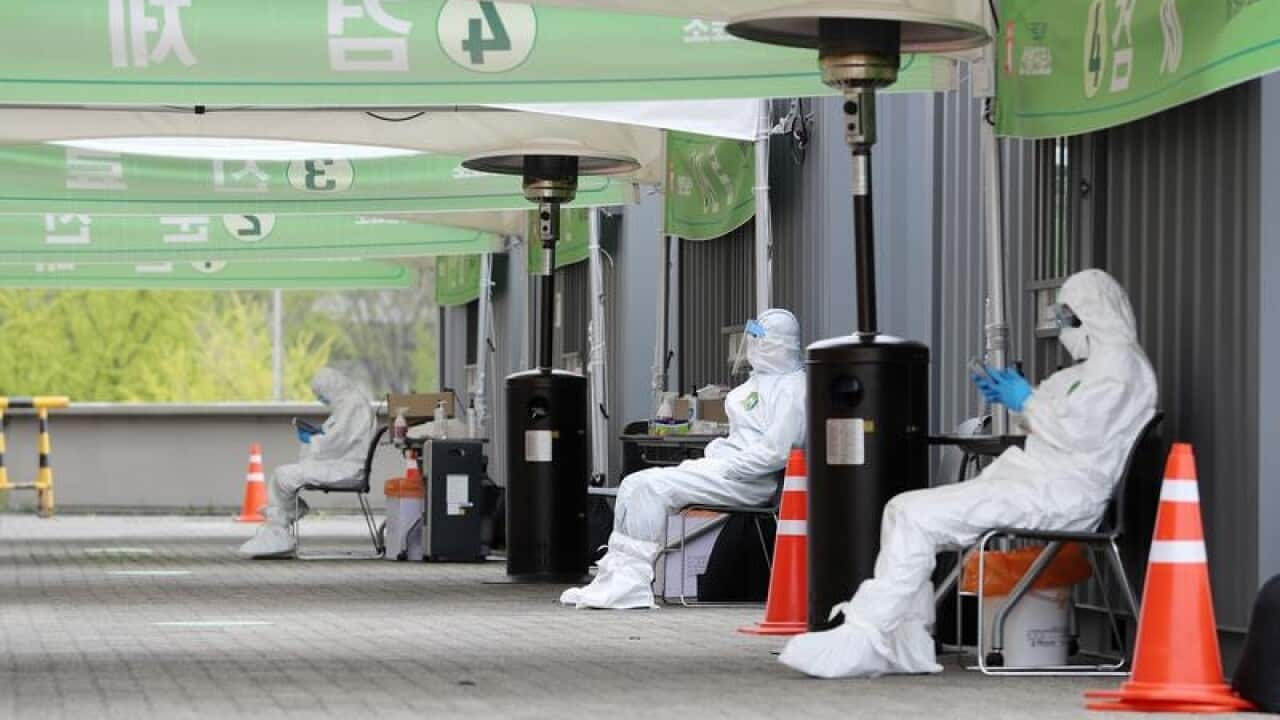South Korea has extended its social distancing policy for another 16 days but offered some relief for churches and sporting fixtures, as it reported just eight new coronavirus infections, the lowest in two months.
The slightly relaxed guidelines mean high-risk facilities like churches will no longer have to close, while sports matches such as soccer can resume without an audience.
"It is safest to maintain the intensive social distancing, but it isn't easy realistically. We need to find a middle ground," Prime Minister Chung Sye-kyun told a televised meeting of government officials on Sunday.
"If we can maintain a stable management at the current level, we will shift to 'routine social distancing' from May 6," Chung said.
Health authorities have said this would allow a reopening of the economy, while maintaining guidelines on disinfection and preventing the spread of the virus in people's daily lives.
It was the first time since 18 February that South Korea reported a single-digit daily rise in new infections. The figure brings its total cases to 10,661.
Of the new cases, five were imported from overseas, the Korea Centres for Disease Control and Prevention said. The death toll rose to 234.
South Korea has largely managed to bring the outbreak under control and has recently been reporting daily new cases hovering around 20.
Health authorities called the trend good news, but issued a note of caution about overly optimistic predictions.
"We are continuously on the alert to ensure we haven't missed any new infections, or whether the epidemic could be spread by asymptomatic or mildly infected patients," KCDC chief Jeong Eun-kyeong told a briefing.
President Moon Jae-in on Sunday said South Korea's progress gave hope that the COVID-19 is "surmountable" in other parts of the world. Earlier this year, South Korea had Asia's largest number of infections outside China. It has since been overtaken by other countries.
"The government will prepare for new daily lives and the new world order 'post-COVID' with the unified power of the citizens," Moon said.
China cases also down
China has reported 16 new confirmed coronavirus cases on 18 April, the lowest since 17 March and down from 27 a day earlier, according to data.
Despite the declines in new confirmed cases, authorities are still on guard against a major resurgence, which could be socially and economically destabilising.
Notably, the northeastern province of Heilongjiang has seen a surge in infected travellers arriving from Russia in recent weeks, and is now battling to contain a flare-up in local cases.
The data from China's National Health Commission published on Sunday shows nine of the new cases reported on Saturday were imported infections, the lowest since March 13 and down from 17 a day earlier.
The remaining seven confirmed cases were locally transmitted, down from 10 the previous day. The total number of confirmed coronavirus cases in the mainland reached 82,735 as of April 18, while the total death toll from the virus stood at 4632.
The total number of confirmed coronavirus cases in the mainland reached 82,735 as of April 18, while the total death toll from the virus stood at 4632.

People wearing protective face masks walking at a shopping area in Wuhan, China. Source: AAP
Heilongjiang has reported 39 new local cases in the past 10 days, or more than 50 per cent of all the new 73 local cases reported in the mainland during the same period.
Most of the cases were related to one imported case in the provincial capital Harbin.
On Friday, a total of 18 officials in Harbin, including a vice mayor, were punished.
To contain the outbreak quickly, the Heilongjiang government is cautioning against family gatherings, cross infections at hospitals, and slow reporting in epidemic investigations, according to a statement on the provincial government website.
"The biggest political task at present is to stop the rebound and spread of the epidemic," Wang Yongkang, vice governor of Heilongjiang, was quoted as saying.
Elsewhere in mainland China, all areas in central Hubei province including Wuhan, the epicentre of the outbreak in China, are now considered low-risk.
However, a Beijing central district is seen as high-risk, according to a social media post by the State Council, or cabinet.
On April 15, the Chinese capital reported three local cases, all of which were linked to an imported infection.
Areas that are considered of medium-risk in China include two districts in Harbin, the city of Suifenhe in Heilongjiang, two districts in the southern city of Guangzhou and Jiaozhou city in eastern Shandong province.
In mainland China, newly discovered asymptomatic cases stood at 44, down from 54 a day earlier. Three of the new cases were imported, according to the health commission.
China does not include asymptomatic cases, or patients who test positive but show no clinical symptoms such as a cough or fever, in its tally of confirmed cases.
No new deaths were reported, it said.
People in Australia must stay at least 1.5 metres away from others and gatherings are limited to two people unless you are with your family or household.
If you believe you may have contracted the virus, call your doctor (don’t visit) or contact the national Coronavirus Health Information Hotline on 1800 020 080.
If you are struggling to breathe or experiencing a medical emergency, call 000. SBS is committed to informing Australia’s diverse communities about the latest COVID-19 developments.












